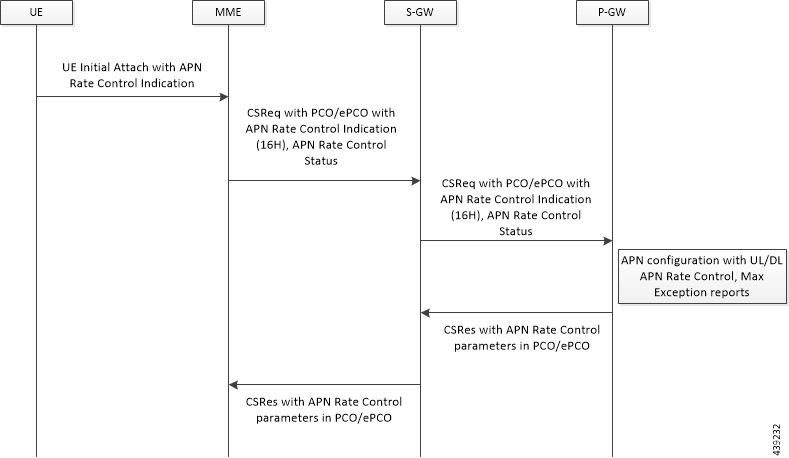APN Rate Control policing for DL is done in the P-GW or the SCEF, and the APN Rate Control policing for UL is done in the
UE. The P-GW or SCEF can also do APN Rate Control UL policing. For more information on:
-
APN Rate Control UL in the UE, see 3GPP TS 24.301.
-
APN Rate Control in the SCEF, see 3GPP TS 29.128.

Note |
The existing AMBR mechanisms are not suitable for APN Rate Control for CIoT Devices considering radio efficiency and UE battery-life.
For example, an AMBR greater than 100 Kbps translates to a potentially large daily data volume.
|
The P-GW or Service Capability Exposure Function (SCEF) sends an APN Uplink Rate Control command to the UE using the PCO information
element (IE). The APN Uplink Rate Control applies to data PDUs sent on that APN by either Data Radio Bearers (S1-U) or Signaling
Radio Bearers (NAS Data PDUs). The UE complies with this uplink rate control instruction. The UE considers the rate control
instruction as valid until it receives a new one from either P-GW or from SCEF. The P-GW or SCEF enforces the Uplink Rate
Control by discarding or delaying packets that exceed the rate as indicated to the UE.
APN Rate Control Indications
APN Rate Control Indication Status is sent as part of Protocol Configuration Options (PCO)/Extended Protocol Configuration
Options (ePCO). If P-GW/MME supports the ePCO as part of its capability exchange, the P-GW/S-GW sends the APN Rate Control
parameters as part of ePCO. If ePCO is not supported by these entities, the P-GW/S-GW sends the APN Rate Control parameters
as part of PCO.
As part of PCO/ePCO, the APN Rate Control parameters are sent as “additional parameters list”. A specific “container identifier”
identifies the type of the parameter that is carried in a container. The “container identifier” related to the APN Rate Control
are:
When the “container identifier” indicates APN Rate Control support indicator, the “container identifier contents” field is
empty and the “length of container identifier contents” indicates a length equal to zero. If the “container identifier contents”
field is not empty, it is ignored. This information indicates that the MS supports APN Rate Control functionality.
When the “container identifier” indicates APN Rate Control parameters, the “container identifier contents” field contains
parameters for APN Rate Control functionality.
When the “container identifier” indicates Additional APN Rate Control for exception data support indicator, the “container
identifier contents” field is empty and the “length of container identifier contents” indicates a length equal to zero. If
the “container identifier contents” field is not empty, it is ignored. This information indicates that the MS supports additional
APN Rate Control for exception data functionality.
When the “container identifier” indicates Additional APN Rate Control for exception data parameters, the “container identifier
contents” field contains parameters for additional APN Rate Control for exception data functionality.
APN Rate Control Status
APN Rate Control Status is the new IE, added as part of Create Session Request (CSReq), Delete Bearer Request (DBReq), and
Delete Session Response (DSRes), which holds information of APN Rate Control Value. This IE is encoded as part of CSReq on
the UR reattach to denote the P-GW about the remaining limits available for the subscriber on the current timeout period.
P-GW includes this IE when the DBReq is sent only for the default bearer, so that it can be used when the UE is attaching
again. In addition, the P-GW includes this IE when the DSRes is sent to MME through S-GW.
| |
Bits |
|
| Octets |
8 |
7 |
6 |
5 |
4 |
3 |
2 |
1 |
|
| 1 |
Type = 204 (decimal) |
|
| 2 to 3 |
Length = n |
|
| 4 |
Spare |
Instance |
|
| 5 to 8 |
Number of Uplink packets allowed |
|
| 9 to 12 |
Number of additional exception reports |
|
| 13 to 16 |
Number of Downlink packets allowed |
|
| 17 to 24 |
APN Rate Control Status validity Time |
|
| 25 to (n+4) |
These octet(s) is/are present only if explicitly specified |
|
Octets 17 to 24 are coded as time in seconds relative to 00:00:00 on 1 January 1900 (calculated as continuous time without
leap seconds and traceable to a common time reference) where the binary encoding of the integer part is in the 32 most significant
bits, and binary encoding of the fraction part in the 32 least significant bits. The fraction part is expressed with a granularity
of 1/2**32 second.
The APN Rate Control Status information is sent by P-GW to MME through S-GW to store the APN Rate control parameters in Mobility
Management (MM) context. This helps in restoring the rate control for the same subscriber when it is reestablished again after
some time. The parameters are treated as the remaining messages on the remaining time period of the time-unit.
On reestablishment of the same subscriber (on first PDN for the same APN), the MME provides the information back to P-GW in
PCO/ePCO. While processing, P-GW considers the values received from MME instead of its local configuration until the first
timeout is complete.




 Feedback
Feedback